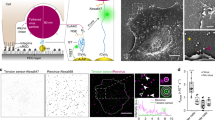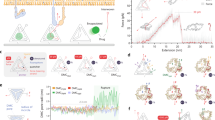Abstract
Non-viral gene vectors are commonly used for gene therapy1,2,3 owing to safety concerns with viral vectors4. However, non-viral vectors are plagued by low levels of gene transfection and cellular expression1,2. Current efforts to improve the efficiency of non-viral gene delivery are focused on manipulations of the delivery vector5,6,7,8,9,10,11,12, whereas the influence of the cellular environment in DNA uptake is often ignored. The mechanical properties (for example, rigidity) of the substrate to which a cell adheres have been found to mediate many aspects of cell function including proliferation, migration and differentiation13,14,15,16,17, and this suggests that the mechanics of the adhesion substrate may regulate a cell's ability to uptake exogeneous signalling molecules. In this report, we present a critical role for the rigidity of the cell adhesion substrate on the level of gene transfer and expression. The mechanism relates to material control over cell proliferation, and was investigated using a fluorescent resonance energy transfer (FRET) technique18,19,20,21. This study provides a new material-based control point for non-viral gene therapy.
This is a preview of subscription content, access via your institution
Access options
Subscribe to this journal
Receive 12 print issues and online access
$259.00 per year
only $21.58 per issue
Buy this article
- Purchase on Springer Link
- Instant access to full article PDF
Prices may be subject to local taxes which are calculated during checkout





Similar content being viewed by others
References
Niidome, T. & Huang, L. Gene therapy progress and prospects: Nonviral vectors. Gene Ther. 9, 1647–1652 (2002).
Jiao, S. S., Gurevich, V. & Wolff, J. A. Long-term correction of rat model of Parkinsons-disease by gene therapy. Nature 362, 450–453 (1993).
Shea, L. D., Smiley, E., Bonadio, J. & Mooney, D. J. DNA delivery from polymer matrics for tissue engineering. Nature Biotechnol. 17, 551–554 (1999).
Christiano, R. Viral and non-viral vectors for cancer gene therapy. Anticancer Res. 18, 3241–3246. (1998).
Brown, M. D., Gschatzlein, A. & Uchegbu, I. F. Gene delivery of synthetic (non viral) carriers, Int. J. Phamaceut. 229, 1–21 (2001).
Schaffer, D. V. & Laffenburger, D. A. Optimization of cell surface binging enhanced efficiency and specificity of molecular conjugate gene delivery. J. Biol. Chem. 273, 28004–28009 (1998).
Boussif, O. et al. A versatile vector for gene and nucleotide transfer into cells in culture and in vivo-polyethyleneimine. Proc. Natl Acad. Sci. USA 92, 7297–7301 (1995).
Felgner, P. et al. Lipofection-highly efficient, lipid-mediated DNA-transfection procedure. Proc. Natl Acad. Sci. USA 84, 7413–7417 (1987).
Adami, R. C. et al. Stability of peptide condensed plasmid DNA formulation. J. Pharmaceut. Sci. 87, 678–683 (1998).
Salem, A. K., Searson, P. C. & Leong, K. W. Multifunctional nanorods for gene delivery. Nature Mater. 2, 668–671 (2003).
Luo, D. & Saltzman, W. M. Enhancement of transfection by physical concentration of DNA at the cell surface. Nature Biotechnol. 18, 893–895 (2000).
Shen, H., Tan, J. & Saltzman, W. M. Surface-mediated gene transfer from nanocomposites of controlled texture. Nature Mater. 3, 569–574 (2004).
Galbraith, C. & Sheetz, M. P. Forces on adhesive contacts affect cell function. Curr. Opin. Cell Biol. 10, 566–571 (1998).
Pelham, R. J. & Wang, Y. L. Cell locomotion and focal adhesions are regulated by substrate rigidity. Proc. Natl Acad. Sci. USA 94, 13661–13665 (1997).
Wang, H. B., Dembo, M. & Wang, Y. L. Substrate inflexibility regulates growth and apoptosis of normal but not transformed cells. Am. J. Physiol. Cells 279, C1345–C1350 (2000).
Engler, A. J. et al. Myotubes differentiate optimally on substrates with tissue-like stiffness: pathological implications for soft or stiff microenvironments. J. Cell Biol. 166, 877–887 (2004).
Kong, H. J., Polte, T., Alsberg, E. & Mooney, D. J. FRET measurements of cell-traction forces and nano-scale clustering of adhesion ligands varied by substrate stiffness. Proc. Natl Acad. Sci. USA 102, 4300 (2005).
Murphy, M. C., Rasnik, I., Cheng, W., Lohman, T. M. & Ha, T. Probing single-stranded DNA conformational flexibility using fluorescence spectroscopy. Biophys. J. 86, 2530–2537 (2004).
Itaka, K., Harada, A., Nakamura, K., Kawaguchi, H. & Kataoka, K. Evaluation by fluorescence resonance energy transfer of the stability of nonviral gene delivery vectors under physiological conditions. Biomacromol. 3, 841–845 (2002).
Madeira, C., Loura, L. M. S., Aires-Barros, M. R., Fedorov, A. & Prieto, M. Characterization of DNA/lipid complexes by fluorescence resonance energy transfer. Biophys. J. 85, 3106–3119 (2003).
Itaka, K., Harada, A., Yamasaki, Y., Nakamura, K., Kawaguchi, H. & Kataoka, K. In situ single cell observation by fluorescence resonance energy transfer reveals fast intra-cytoplasmic delivery and easy release of plasmid DNA complexed with linear polyethylenimine J. Gene Med. 6, 76–84 (2004).
Rowley, J. A., Sun, Z. X., Goldman, D. & Mooney, D. J. Biomaterials to spatially regulate cell fate. Adv. Mater. 14, 886–889 (2002).
Tseng, W. C., Haselton, F. R. & Giorgio, T. D. Mitosis enhances transgene expression of plasmid delivered by cationic liposomes. Biochim. Biophys. Acta 1445, 53–64 (1999).
Escriou, V., Carriere, M., Bussone, F., Wils, P. & Scherman, D. Critical assessment of the nuclear import of plasmid during cationic lipid-mediated gene transfer. J. Gene Med. 3, 179–187 (2001).
Rowley, J. A. & Mooney, D. J. Alginate type and RGD density control myoblast phenotype. J. Biomed. Mater. Res. 55, 503–511 (2001).
Bonadio, J., Smiley, E., Patil, P. & Goldstein, S. Localized, direct plasmid gene delivery in vivo: prolonged therapy results in reproducible tissue regeneration. Nature Med. 5, 753–759 (1999).
Huang, Y. C., Cennell, M., Park, Y., Mooney, D. J. & Rice, K. G. Fabrication and in vitro testing of polymeric delivery system for condensed DNA. J. Biomed. Mater. Res. 67A, 1384–1392 (2003).
Lakowicz, J. R. Principles of Fluorescence Spectroscopy (Kluwer Academic/Plenum, New York, 1999).
Acknowledgements
We thank Michael Solomon at the University of Michigan for use of the laser scanning confocal microscope. We also thank Yoshiaki Hirano at Osaka University for helpful discussions. Financial support was provided by the National Institute of Health (R30 DE 13033).
Author information
Authors and Affiliations
Corresponding author
Ethics declarations
Competing interests
The authors declare no competing financial interests.
Supplementary information
Supplementary Information
Supplementary information and supplemental figure 1 (PDF 184 kb)
Rights and permissions
About this article
Cite this article
Kong, H., Liu, J., Riddle, K. et al. Non-viral gene delivery regulated by stiffness of cell adhesion substrates. Nature Mater 4, 460–464 (2005). https://doi.org/10.1038/nmat1392
Received:
Accepted:
Published:
Issue Date:
DOI: https://doi.org/10.1038/nmat1392
This article is cited by
-
Non-viral gene delivery to human mesenchymal stem cells: a practical guide towards cell engineering
Journal of Biological Engineering (2023)
-
An inhaled bioadhesive hydrogel to shield non-human primates from SARS-CoV-2 infection
Nature Materials (2023)
-
Development of a fibrin-mediated gene delivery system for the treatment of cystinosis via design of experiment
Scientific Reports (2022)
-
Physical and mechanical cues affecting biomaterial-mediated plasmid DNA delivery: insights into non-viral delivery systems
Journal of Genetic Engineering and Biotechnology (2021)
-
Development of a semi-crystalline hybrid polyurethane nanocomposites for hMSCs cell culture and evaluation of body- temperature shape memory performance and isothermal crystallization kinetics
Journal of Polymer Research (2021)



